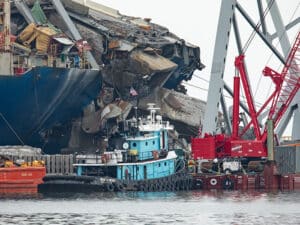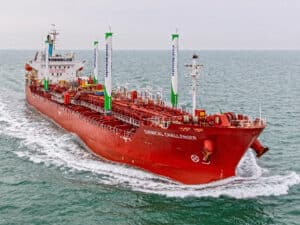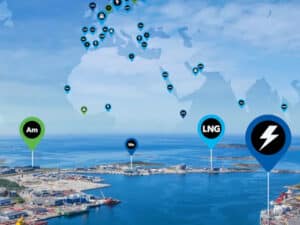
Op-Ed: Turning the corner on emissions, waiting is not an option
Written by
Svetlana Rjedkin, author
By Svetlana Rjedkin, Bunker and Lubricant Broker/Trader at KPI OceanConnect
Where does the industry need to be?
The marine fuel supply chain is rapidly transforming on the back of increased regulation, as well as the demands from charterers, shippers, financiers and consumers for increased transparency, efficiency and sustainability.
Sulfur emissions were managed successfully across the maritime industry following the implementation of the International Maritime Organization’s (IMO) 2020 Global Sulfur Cap, despite concerns that the transition would cause significant disruption. Shipping now faces a more complex transition in decarbonization, which will change the marine fuels supply chain in ways we have not seen before. Multiple new fuel pathways will come into the market to offer new products. This will require significant changes to the global bunkering infrastructure, as well as collaboration and transparency to achieve these targets.
The industry is already exploring and monitoring a range of future fuels and sources of energy, which will produce effective carbon-neutral fuels. However, with so many options being proposed, navigating this market will require knowledge, innovation and close collaboration between marine energy providers, ship owners and operators.
The coming market transformations are complex, with so many new fuels and new sources of energy vying for adoption, from biofuels, ethanol and methanol to the “unicorn fuel” of hydrogen-based products synthesized using renewable electricity. In the short-term, the level of biogenic or synthetic fuels blended into fossil-derived fuels will also grow. Presently, LNG and MGO are being blended with up to 20% of their biogenically sourced versions. We recognize that ship owners and operators will be reliant on marine energy providers to help them develop a strategy to manage the short and medium term changes.
The Poseidon Principles and Sea Cargo Charter initiatives are driving transparency and action in the supply chain, demanding owners and operators to demonstrate their strategies for sustainable and accountable operations. Adopting blended fuels and new fuels as supplies grow will be crucial to meeting these requirements. Along with their in-depth knowledge of the fuels market and financial strength, marine energy providers are going to be essential partners for owners and operators to navigate this transition.
Supply and demand will grow hand in hand, but the question remains as to whether the growth of carbon-neutral fuels will develop fast enough to achieve the IMO’s targets for 2030 and 2050. The reality is that the industry needs to act now to turn the corner on emissions, and do all it can to tackle decarbonization. As well as moving towards a new and more complex supply chain, the industry needs to adapt and be aware of other mechanisms designed to tackle carbon emissions. One of these is emissions trading and carbon credits.
Considering the carbon footprint of bunkering today
One of the most prominent plans for a market-based approach to managing carbon credits is the European Union’s Emissions Trading Scheme (EU ETS). Since 2005, the EU has used this program to impose a cap on carbon emissions by the energy and aviation industries, while setting a price on Greenhouse Gas (GHG) emissions. The current proposal states that from January 1, 2024, shipping will be included in this scheme. By 2026, the EU will expect each vessel to have permits covering all emissions inside the EU, and 50% of emissions from international voyages that start or end in EU ports. In the United States, additional legislation aimed at reducing the maritime industry’s carbon footprint was introduced on July 11, 2022, through the Clean Shipping Act of 2022.
This scheme will certainly make the industry more focused, but it also introduces risk. Carbon permits can be traded by anyone and they need to cover all emissions by an operation in any given year. If companies get this process wrong, it could impact the profitably, efficiency, sustainability, and competitiveness of operations. Under EU ETS, businesses that fail to accurately forecast and plan for their emissions will need to buy permits on the spot market where prices are volatile. Failure to cover emissions with permits acquired in advance can be costly. An experienced, knowledgeable partner will be able to help you forecast your needs and plan how to manage your permits properly.
Payments under EU ETS will be invested into programs aimed at reducing GHG emissions and tackling climate change in the EU. But if a voyage does not involve the EU, what options are open to operators who still need to meet stakeholder expectations around managing and reducing carbon budgets?
Taking action to achieve change
With net-zero fuel options currently limited, voluntary carbon offsetting is available now and can make a beneficial contribution to deliver sustainable shipping. It is not yet operationally feasible to decarbonize as rapidly or as fully as many would like. For example, green fuels are only available in small scales in a limited number of ports and many vessels operate engines that are not capable of using greener marine fuels.
As a result of this, carbon offsetting will be part of shipping’s decarbonization journey and can make a beneficial contribution to developing a sustainable low-carbon industry. Carbon offsets can credibly balance vessel GHG emissions by funding certified projects that generate clean and renewable energy, including wind farms, solar energy and reforestation.
While the sector will have to wait for wider availability of low-carbon and net-negative marine fuels, offsetting allows shipping to take immediate action to reduce global emissions. Offsetting programs can be based anywhere and often are renewable energy projects in lower-income countries that would not be built any other way. For operators in the shipping industry looking to meet their sustainability obligations, a partner with experience in offsetting fuels and the global maritime industry can help them to make a real impact.
In 2021, KPI OceanConnect completed one of the first carbon-neutral fuel supplies in the industry by offsetting a transaction involving a respected seismic research vessel and long-term client. The voluntary carbon units were derived from a wind farm in Texas and verified by Verra Registry. Carbon offsetting is a viable pathway for reducing the emissions impact of traditional and alternative fuels and will allow marine energy providers and their clients to remain agile and innovative in the face of a changing fuel landscape.
As part of their strategy for decarbonization, owners and operators should have an offsetting strategy to help with their transition. This needs to be in place before the EU’s ETS starts to apply to the sector in January 2024, so that the right permits can be acquired at a price that allows operations to continue without disruption and without unsustainably raising costs. The price of offsets for EU ETS has been rising, caused by the increasing use of coal in parts of the EU over recent years to meet growing electricity demand.
As the EU imposes levies on users of its ports for their carbon emissions, responsible businesses are going to want to align their business in the rest of the world with the standards they meet in the EU. Currently the only way to do this will be using voluntary carbon offsets. These programs can be tied directly to the quantity of fuel an operator purchases and with the help of an expert marine fuels provider the sector can make sure that its offsetting activity not only acts as a crucial additional tool in the fight to deliver decarbonization and that it does so effectively across the global economy, wherever it is needed.




